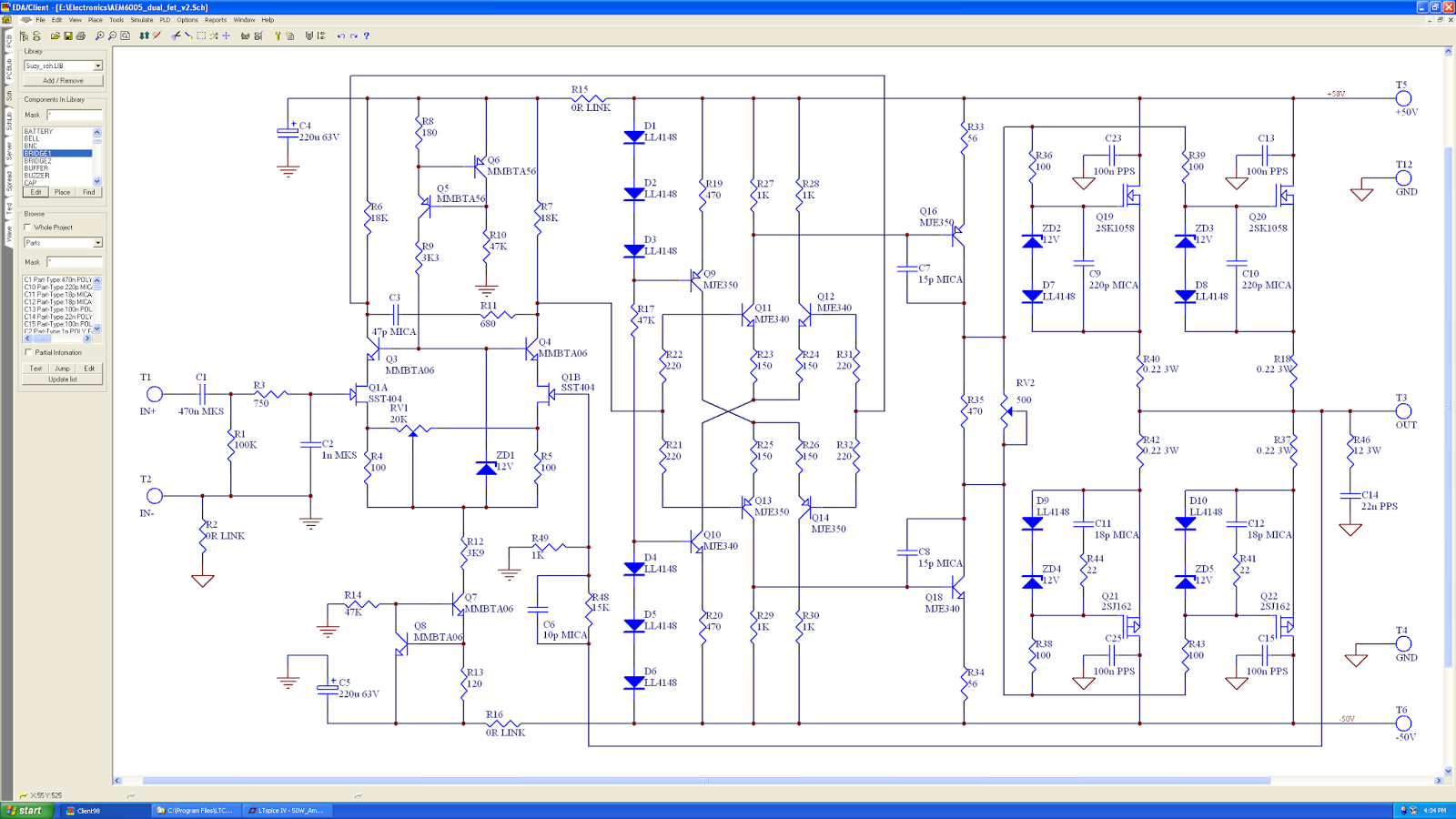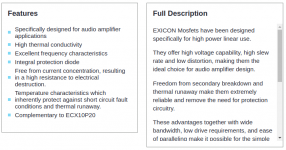Lateral FETs are easy to drive. No need to use followers as the capacitance is small. No need to use VBE multiplier as the FET itself has a negative tempco above ~100mA. I'd favour your second circuit.
This is what I do in my amps. Works reasonably well.

This is what I do in my amps. Works reasonably well.

N101N, whats your view on why cct2 is oscillating?
It's vague nonsense as i see...
😀
That`s a beautiful consensus...
ctrlx,
the cct2 should be stable without any phase compensation capacitor, but the common emitter drivers need to be dedicated (video) transistors with very small Cob which are unfortunately not easily obtainable these days. Types such as the BD139 or the MJE340 are outright unsuitable for the job.
Again, I am strongly against the presence of Q5/Q6.
ctrlx,
the cct2 should be stable without any phase compensation capacitor, but the common emitter drivers need to be dedicated (video) transistors with very small Cob which are unfortunately not easily obtainable these days. Types such as the BD139 or the MJE340 are outright unsuitable for the job.
Again, I am strongly against the presence of Q5/Q6.
Types such as the BD139 or the MJE340 are outright unsuitable for the job.
Phhht. MJE340/350 are perfectly fine for latfet drivers in a typical 0.001% amplifier. They're good for 300V, 500mA, and have fT of something resembling 20MHz. BD139/140 are a bit limited in terms of voltage...
There's also 2SC3503/2SA1381 for something a little quicker (150MHz fT, 3pf Cob), which are common as muck, but they're a tad more delicate (Ic 100mA)... The circuit I posted earlier makes 1ppm THD at 1KHz with the 2SC3503/2SA1381. (see Suzy's Blog: Measuring a MOSFET Power Amplifier.)
The way I figure, you can either design using the parts that are available, or sob in your beer about unobtainum transistors from 1987, and get nothing done.
It`s a matter of bandwidth not voltage and current. What is the Cob of the MJE340? You don't want to know. The Japanese made lots of excellent video transistors in the CRT screen era. Sadly, what is now generally available for audio is junk.
Yes, they did... And now they don’t.
And yet there are still plenty of very fast, very linear amplifiers using currently available parts...
And yet there are still plenty of very fast, very linear amplifiers using currently available parts...
I simulate my amps using circuit boards, parts and solder. I measure using oscillators and creaky old spectrum analysers.
You?
You?
The Japanese made lots of excellent video transistors in the CRT screen era. Sadly, what is now generally available for audio is junk.
but the common emitter drivers need to be dedicated (video) transistors with very small Cob which are unfortunately not easily obtainable these days.
Not so clearly.
Ksa1381/ksc3503 are in small production and available now for VAS output and OPS low-capacitance input.
Ksa1220a/ksc2690a are perfect powerful drivers for mostly all home audio amplifiers up to 500wt/8ohm power.
Anyway there are no one schematic here at diyaudio which demands for such a powerful and fast drivers. The best one like YAPamp have compensation base-collector capacitance at driver stage of ~100 pF order.
There are no designed OPS which demands for driver to shoot-through current to load through huge base-emitter capacitance of the low-freq output devices like MJL21193/4 while common EF-triple without sacrificing bandwidth of second stage are unstable and fast driver are unneeded.
Last edited:
🙂
This topology should be stable without any phase compensation capacitor. Zener diodes are far too slow and provide no protection against transient voltages. The lateral FETs have internal protection diodes.
>The lateral FETs have internal protection diodes.
Is this confirmed? Exicon LatFets?
I've seen this claim before, but still - most of latfet amp schematics here on DIY have them.
Is this confirmed? Exicon LatFets?
I've seen this claim before, but still - most of latfet amp schematics here on DIY have them.
Is this confirmed? Exicon LatFets?
Old Russian depletion MOSFETs like KP901 and triple-die KP904 have no protection and was extremely sensitive for static discharge.
All modern LatFETs are yilded from one/same techprocess and i suppose even with one set of litographical masks designed by Toshiba/Renesas/Hitachi engineers.
No profit from redevelop/reinvent bicycle.
AFAIK, iternal diode/zener pair was rated at 15 Volts and 0,1 ma, so you can easily use 24 V supply and 0.05 mA current regulator (for safety) and just check your ones.
The main reason of dead crystals was really excessive static discharge overrated dv/dt or SOA of internal diodes/zeners, so external ones are additional as more powerful.
I simulate my amps using circuit boards, parts and solder. I measure using oscillators and creaky old spectrum analysers.
You?
You're so outdated... 😀
It sounds much more natural with simulation, physical amps are outdated to..

"Integral protection diode" - this could be a diode between S-D (which all fets have),
not a Gate protection Zener...
They don't explicitly say "Gate protection diode".
Last edited:
"Integral protection diode" - this could be a diode between S-D (which all fets have),
not a Gate protection Zener...
They don't explicitly say "Gate protection diode".
No.
Body diode is not a protection one.
- Home
- Amplifiers
- Solid State
- driving lateral mosfets
